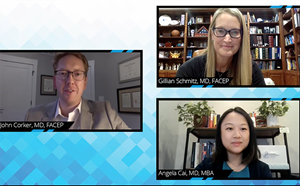
Pandemic Policy Primer
By Puneet Gupta, MD, FACEP, Legislative Advisor, ACEP Young Physicians Section
COVID-19 was unexpected. With its never-before-seen infectivity, mortality, and long-term effects, the governments of the world were caught flatfooted, as was the medical community. We needed to change the way we did things, and we needed to do so with a speed that had never been seen before. We were about to find out how fast humanity could truly move. As fast as a virus that changed the world.
To fully understand pandemic policy1, unprecedented in its speed and spending for these modern times, we must understand not only where we are, but what’s on the horizon.
Where are we?
The United States government has been rolling out its response to SARS-CoV-2 in phases:
Phase 1 – Coronavirus Preparedness and Response Supplemental Appropriations Act (Signed into law on March 6, 2020)
- More than $3 billion for research and development of vaccines, diagnostic tests, and therapeutic interventions
- $2.2 billion for public health funding for aid in prevention, preparedness and response efforts
- Almost $1 billion for medical supplies, health-care preparedness, Community Health Centers and medical surge capacity
- $1.25 billion for international efforts
Phase 2 – Families First Coronavirus Response Act (Signed into law on March 18, 2020)
- A $104 billion aid package focused on paid sick leave, free coronavirus testing, expansion of unemployment benefits and increased funding for food stamps
Phase 3 – Coronavirus Aid, Relief, and Economic Security Act (CARES) Act (Signed into law on March 27, 2020)
The total cost was approximately 2.2 trillion – the largest economic stimulus package in U.S. history.
- $300 billion in one-time cash payments to individual Americans
- $260 billion increase in unemployment benefits
- Creation of the Paycheck Protection Program providing forgivable loans to small businesses with an initial $350 billion in funding, later increased to $669 billion by the Paycheck Protection Program and Health Care Enhancement Act signed on April 24, 2020
- $100 billion for Provider Relief Fund to help support hospitals and physicians
- Deferred federal student loan payments, principal, and interest through September 30, 2020
Phase 4 – Paycheck Protection Program and Health Care Enhancement Act (Signed into law on April 24, 2020)
- $321 billion more for Paycheck Protection Program
- $75 billion more for Provider Relief Fund
Where are we going?
To understand where we’re going, we need to realize what’s paving the road. Particular to the house of medicine, there are two major concerns:
- How does this affect emergency medicine? In 2019, approximately 49 percent of the US population received their health insurance from employers. With our current situation, more and more individuals are becoming dependent on Medicaid (the insurance for those below a certain income bracket).
- As we know, there has been a significant decrease in access to care secondary to medical professionals being unable or unwilling to expose themselves to the virus.
What does this mean for the future?
To begin with, we all realize another stimulus bill is needed. The previous four passed with a bipartisan majority but as our situation has developed, the fifth COVID relief package has become a much more complicated and polarizing issue.
The House Democrats have fielded the HEROES (Health and Economic Recovery Omnibus Emergency) Act, and the Senate Republicans have fielded the Health, Economic Assistance, Liability Protection and Schools (HEALS) Act. These are so hotly-debated that even the Senate Republicans were fighting the bill in their own chamber. At this time, a compromise has not been reached. Below is a very quick comparison between the two bills. Keep in mind that regardless of the compromise reached, they will need to include the White House in their negotiations or their final bill may still be vetoed.
What’s the difference between the HEROES and the HEALS act?
|
|
CARES (from March) |
HEROES |
HEALS |
|
Total cost of stimulus package |
$2.2 trillion |
$3 trillion |
$1 trillion |
|
Stimulus check maximum payment amount |
$1,200 to single filers earning under $75K per year, $2,400 for joint filers under $125K. Reduced $5 per $100 of income above limits. |
Same as CARES. |
Same as CARES. |
|
How much stimulus money you get for dependents |
$500 for dependents, 16 and under. College students, 24 and under, are not eligible. |
$1,200 for dependents, maximum of three. |
$500 for dependents, no age limit. |
|
Enhanced unemployment benefit |
$600 per week in addition to state benefits. |
Same as CARES. |
Initially $200 per week. Then up to $500 per week to match 70% of lost wages when added to state benefits. |
|
How long enhanced unemployment lasts |
Expires July 31 |
January 2021 for most workers, through March 2021 for gig workers, independent contractors, part-time workers and self-employed. |
$200 per week bonus through September. Then 70% matching of lost wages. Extends expiration of federal benefits until Dec. 31. |
|
Paycheck Protection Program |
Allocated $659 billion total in forgivable loans for small businesses, who must use 75% on payroll to be eligible for forgiveness. $130 billion remains, but expires Aug. 8. |
Expands eligibility, eliminates 75% payroll requirement and extends application period to Dec. 31. |
Injects another $190 billion into the PPP fund, expands eligibility and allows businesses to request a second loan. Eliminates 75% payroll requirement and expands approved uses of funds for loan forgiveness. |
|
Employee tax credit |
Tax credit on 50% of up to $10,000 in wages. |
Increases tax credit to 80% of up to $15,000 in wages. |
Increases tax credit to 65% of up to $30,000. |
|
Bonus for employees who start new jobs or are rehired |
Does not address. |
Does not address. |
There could be a return-to-work bonus of up to $450 per week for unemployed workers who secure a new job or are rehired. |
|
Eviction protections and moratorium |
Bans late fees until July 25 and evictions until Aug. 24 on properties backed by federal mortgage programs (Fannie Mae, etc.) or that receive federal funds (HUD, etc.). |
Expands to cover nearly all rental properties in the US, extends eviction moratorium an additional 12 months, allocates $200 billion for housing programs and another $100 billion for rental assistance. |
Does not address. |
|
School reopening |
Does not address. |
$58 billion for grades K-12, $42 billion for higher education. |
$70 billion to K-12 that open for in-person classes, $29 billion for higher education, $1 billion to the Bureau of Indian Education, $5 billion state discretion. |
|
Liability protection from coronavirus illness |
Does not address. |
Does not address. |
5 year liability shield to prevent schools, businesses, hospitals, from being sued over coronavirus-related issues. |
|
Coronavirus testing |
Does not address. |
Does not address. |
$16 billion. |
Comparison between the HEROES and HEALS act via CNET. Last referenced 9/4/202
Lastly, the following are critical issues are also in flux:
- Budget Neutrality: This is one of the most significant upcoming issues. (View ACEP’s comprehensive summary of the proposed rule if you want more information.) CMS has a budget neutrality requirement when it comes to physician Medicare reimbursement that requires any new spending be offset by an equal amount of reductions to ensure the overall program does not increase federal outlays. Given recent events, CMS plans to cut the Medicare physician reimbursement conversion factor across the board by 11 percent. Our EM advocates have fought hard and seen an increase in EM code reimbursement, but this victory has only served to decrease our budget cut to 6 percent. At this time when most emergency groups are struggling to keep the lights on, any further loss of income would be difficult. As such, ACEP Public Affairs has already sent a letter to key committees of Congress requesting that they waive the budget neutrality requirement.3 To send letters to your federal lawmakers on this issue, use ACEP’s Action Alert on this issue.
- Balanced Billing: The insurance industry continues to try to include surprise billing legislation that would be harmful to the practice of emergency medicine and our ability to care for our patients into the next COVID relief package, or any other “must-pass” legislation.
- Due Process for Emergency Physicians: Keep an eye on R. 6910 – this would provide due process protections for “physicians who furnish emergency medical services”
- Nurse Practitioner independent practice – given the lack of access and lack of funding, the use of PAs and NPs has risen significantly, and the Nurse Practitioner lobbies are now pushing for decreased restrictions for nurse practitioner practice. As scope of practice is defined by state legislation, this will differ from state to state.
- Liability Protection: I wanted to address this here, although it is also discussed in the phase 5 packages. Given the lack of access to the resources (e.g. ICU bed availability, outpatient diagnostic procedures or elective surgeries), the medical field has taken on an increased liability risk. As such, there is a push to increase our liability protections for care during the COVID era.
- Mental Health: Our gradual awareness as a profession regarding our poor mental health cumulated with the tragic loss of Dr. Lorna Breen this spring. There is currently a push on multiple fronts to increase our awareness of mental health in healthcare workers and break down barriers that prevent HCWs from seeking crisis support. This includes the recent introduction of the Dr. Lorna Breen Health Care Provider Protection Act. To use ACEP’s Action Alert urging Congress to enact the Dr. Breen bill, click here.
- Movement of COVID data collection from the CDC to the HHS: This has never been done before, and the implications of the movement of data from the CDC to the HHS are unknown. Although there was initially an outcry from researchers, the impact, if any, has not yet been expounded upon.
- Telemedicine – CMS codes for telehealth were created as a temporary measure, but as the “genie is out of the bottle,” our advocacy specialists are optimistic they may become permanent. This would have numerous benefits such as enabling increased access to care given the significant increase in telehealth capabilities across the nation. (ACEP wrote an update here.)
This list may seem like a lot, but it’s just scratching the surface of what’s going on with policy during this pandemic era. If you find it intriguing, there are tons of resources to help you dive further into the fascinating realm of health policy! This is the most crucial time to be involved in advocacy efforts and fight for our profession.
Stay In-the-Know
You’ve already put your life on the line to fight COVID-19, what’s a few clicks to stay updated on our efforts improve the healthcare of our nation and protect the future of EM?
- Sign up for the ACEP 911 Legislative Network for updates direct to your email and become part of our grassroots advocacy.
- Read ACEP’s regulatory blog for weekly, in-depth updates on current issues.
- Watch and participate in the ongoing Capital Minute live webinars with the latest updates from ACEP’s advocacy team.
- Go to ACEP’s Civic Action Center to view this non-partisan resource where you can easily check if you are registered to vote, how to vote early, or request an absentee ballot.
References:
-
This most excellent alliteration was borrowed from Dr.Kyle Fischer, fellowship director in health policy at the University of Maryland.
-
https://www.cnet.com/personal-finance/cares-heals-and-heroes-acts-similarities-and-key-differences/ (referenced 9/2/20)
-
/siteassets/new-pdfs/advocacy/acep-letter-to-sfc-and-wm-on-cy2021-pfs-em-codes----08042021.pdf (referenced 9/3/20)




